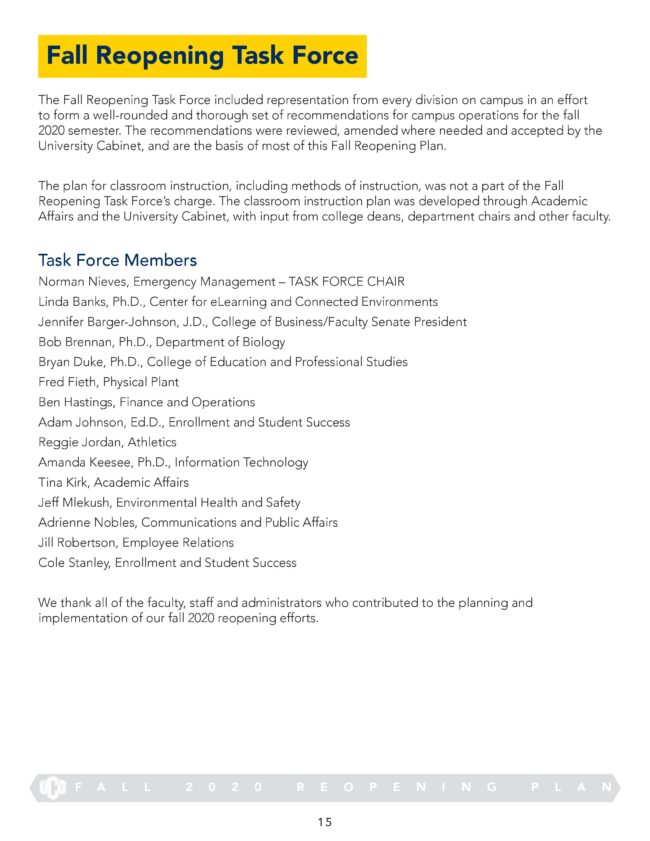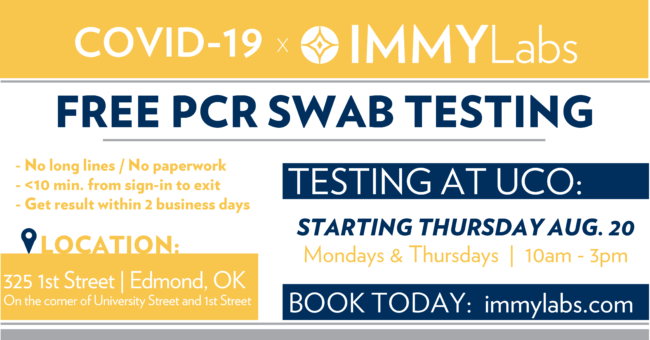University pandemic plans questioned as classes resume
With the return of students to campus and classes resuming with both in-person and virtual delivery, some questions remain regarding the University of Central Oklahoma’s use of resources in implementing reopening plans and whether contingency plans are as detailed as possible.
The Fall Reopening Task Force led by Norman Nieves, Director of Emergency Management, developed the university’s plan. The task force included 15 faculty and staff members, meant to represent every division.
Nieves did not respond to a request for interview regarding the university’s COVID-19 plan.

“Ideally they were going back and asking their areas, ‘Hey this is what we’re thinking, this is what we’re proposing, how is this going to work?’,” said Adrienne Nobles, Vice President for Communications and Public Affairs and task force member. “Did we have the opportunity to go ask every faculty member, every staff member? We did not have that option, in the interest of time.”
The task force did include one microbiologist, Bob Brennan, and Jeff Mlekush who handles much of the campus health and safety concerns, including indoor air quality.
The university recently installed hospital-grade MERV 13 filters in buildings across campus per guidelines from the Centers for Disease Control and Prevention and the American Society of Heating, Refrigerating and Air Conditioning Engineers.
The task force also included those responsible for the successful implementation of new technology and e-learning.
However, the task force failed to include members of departments on campus with additional expertise in emergency management or in dealing first-hand with COVID-19, such as the Department of Nursing. No direct representation from those programs is seen on the task force, leaving some to question the university’s priorities.
According to Nobles, the task force provided information to the faculty senate members and deans for their input. However, the faculty senate is a body of only 35 members responsible for representing the entirety of the university’s faculty of more than 800 full time and adjunct professors and instructors.
UCO’s reopening task force, is just one task force put together in response to the pandemic, according to Alyssa Provencio, coordinator of the university’s certificate in disaster management program.
Despite her qualifications, UCO consulted neither Provencio nor the others who work in the 12-hour program, focused on responding and reducing the impact of emergencies and disasters, as any part of the COVID-19 response.
“There’s been more than one task force,” Provencio said. “For the reopening task force, the deans of the colleges were asked to submit names of faculty that they thought might be good for the task force, but I also know the deans were not contacted afterwards and told why or why not someone was chosen.”
According to Nobles, cabinet members recommended individuals from their respective areas for the task force. The President approved the final list of members.
Additionally, a voluntary survey of faculty conducted by John Wood, Leeda Copley and Nikki Seagraves, members of the UCO chapter of the American Association of University Professors, in mid-July asked respondents to rate various aspects of the university’s COVID-19 response.
Fifty-eight percent of respondents expressed being generally or very dissatisfied with the university’s “consultation with faculty as shared decision makers for fall planning.”
The survey also gauged faculty concerns regarding returning to campus for the fall 2020 semester and the effects of COVID-19.
The AAUP survey found that 94% of respondents worry sometimes, often, or very often, about their own health, the health of their colleagues or loved ones. Even more respondents, 96%, worry about the health of their students.
Separately, the university developed and announced its Fall 2020 Contingency Plan, just last week. The contingency plan broadly outlines how UCO will respond to any spike in COVID-19 cases that would necessitate a shift back to alternative instructional delivery methods.
The plan gives basic instructions for changes to classroom delivery, campus facilities, housing, dining and events on campus. However, the university does not provide specifics in the plan or numbers that would warrant a shutdown.
Nobles said,
“There isn’t a set threshold as to when we would enact that plan and that was deliberate because we want the flexibility to be able to respond when needed rather than saying we have to reach this certain number before something would happen.”
A COVID-19 On-Call Task Force, in conjunction with the University Cabinet and Department of Public Safety will monitor the campus situation continually, according to the plan website. Nobles explained that the on-call task force is a collection of people from the university’s initial response task force in the spring and the reopening task force.
Concerns have been raised online regarding whether some Oklahoma universities are simply waiting until add-drop periods have expired before announcing shifts back to online instruction. This would lock students into paying even if they feel the need to drop a class should it shift to a fully online delivery.
“At this time, there is not a plan to offer reimbursement for classes if the contingency plan is activated [after the add-drop date passes],” Nobles stated. “Faculty have an approved plan in place for each of their classes should we need to activate the contingency plan. The experience would be far different than the rapid switch in March.”
The last day to drop classes in-person and receive a refund at UCO for the fall semester is August 28, according to the academic calendar.
An additional concern is for UCO’s diverse student population. Forty-two and a half percent of university students self-declare as non-white.
This includes international students and those who identify as two or more races. COVID-19 has hit minority communities particularly hard.
“This is going to affect our black and brown and poor students more than it’s going to affect our students who have health insurance and access to good healthcare and also who don’t have to worry about the looks that they get when they wear masks,” Provencio said.
The university has put consideration into the disparate effects of the virus on minority communities, according to Nobles.
“That’s one of the reasons we want to increase access to testing on or close to campus. We want our community here to feel that they have a resource nearby and to address some of those inequities that have come up,” Nobles said.
Nobles confirmed Sunday that IMMY Labs will begin operation of a free drive-through testing option on campus Mondays and Thursdays starting Aug. 20. Tests are open to the community and appointments can be made online.

Reporting positive tests to ensure a timely and appropriate response to them raises a separate area of concern. If a student or faculty member tests positive and exposes his or her class, that entire class could be quarantined at home, according to Nobles.
The university will utilize a team of contact tracers to notify anyone who has been exposed.
Additionally, for professors with symptoms or positive tests, the expectation is to continue teaching remotely as long as their health allows.
“If a faculty member is not capable of delivering instruction due to illness, [that] department will implement their contingency plan and another faculty member (adjunct or full time) will teach until the original faculty member can return,” Nobles stated. “This plan is actually in place during a normal semester, but there is heightened awareness this fall.”
No explanation for where the university would source additional faculty members or how they would be prepared to take on another professor’s classes was given.
If students, faculty or staff contract COVID-19 there is a protocol in place which explains the different procedures.
Oklahoma City Community College, which has a student population close to the size of UCO’s, announced the decision to move its fall semester to a fully online format on July 28.
Oklahoma City University, The University of Oklahoma, Oklahoma State University and Oklahoma Christian University are all offering mixed enrollment options like UCO, with varying degrees of rules and guidelines in place for their respective campus communities.
For more on the university’s response to the COVID-19 pandemic, click here.
This story was last updated at 9:19 a.m. Aug. 18. An earlier version of this story stated that the last day to drop and get a refund was Sept. 24. The actual date is Friday, Aug. 28.

